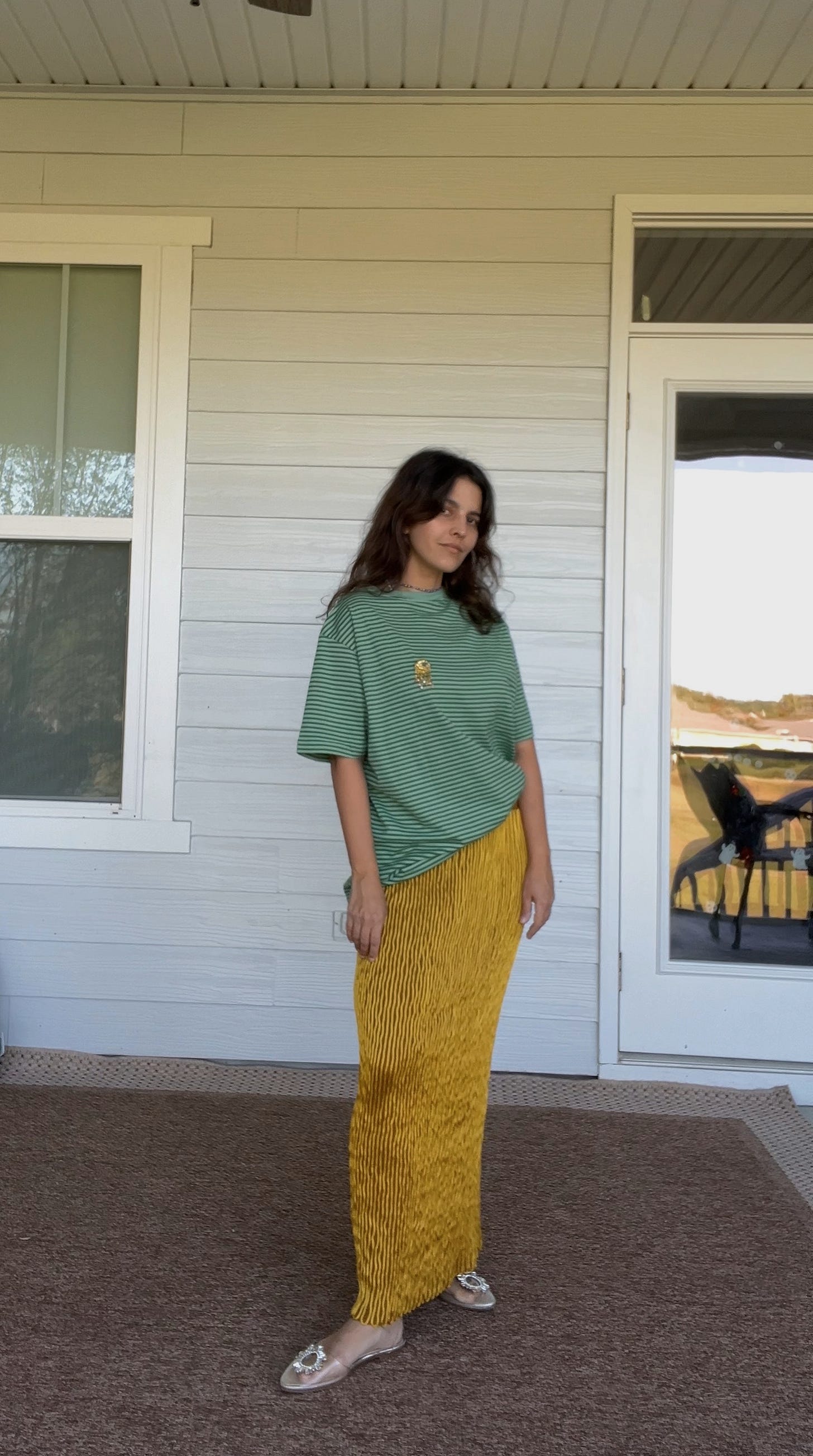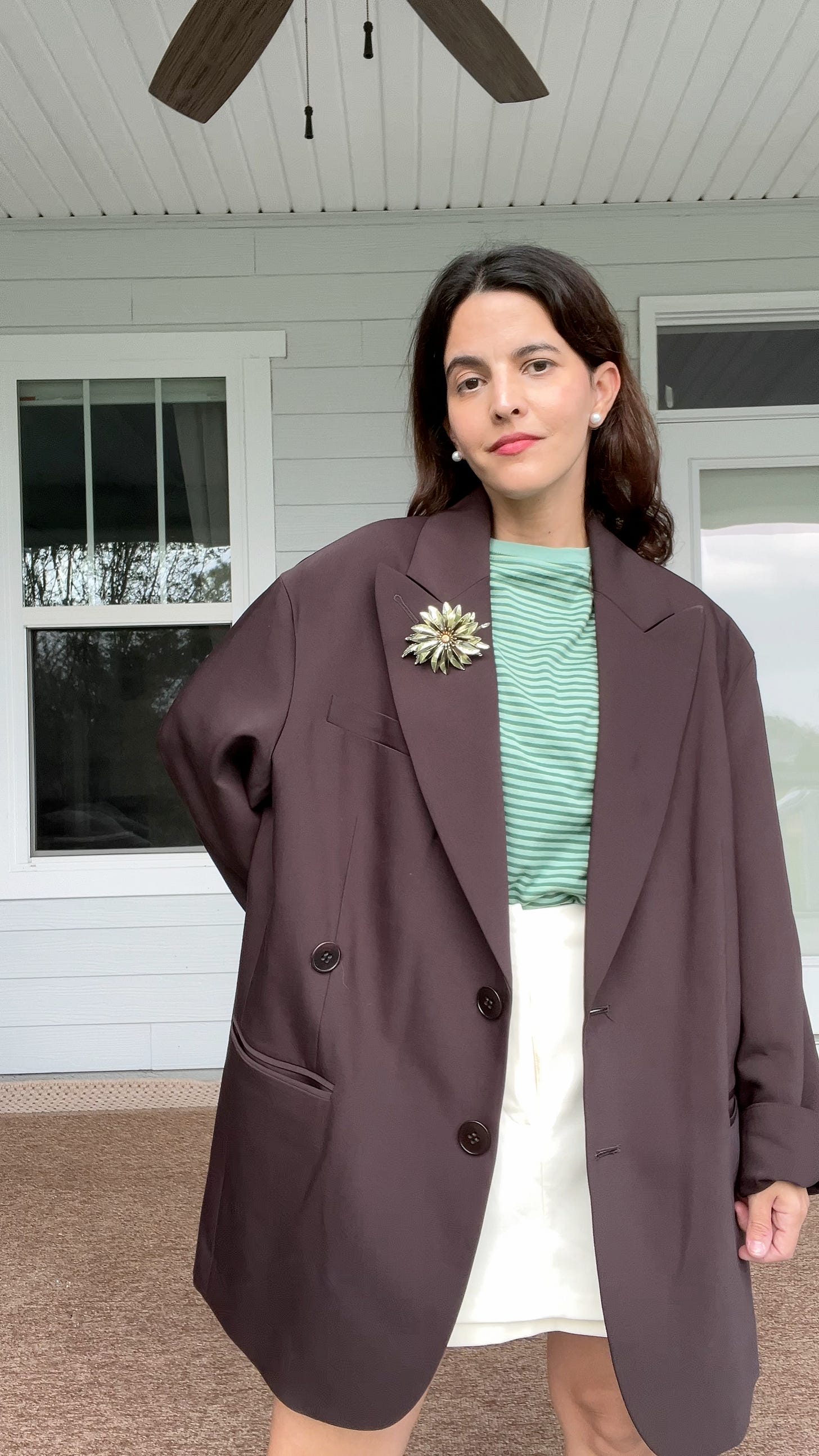The other day when I reached for my jewel-toned marigold Pepa Pombo skirt, it became clear just how much my wardrobe lacks in color and pattern—an inconvenient and, honestly, annoying realization right after I’d embarked on a public no-buy.
I’d pictured pairing the skirt with purples and lilacs, shades and tones of green, and patterns that would create the gestalt I’d been craving. But none of that existed in my closet. I tried to make it work with what I had, but the skirt just felt washed out:
While I loved the looks above in terms of proportions and vibes, I felt like an artist without the materials to finish a painting. I didn’t want just any top that matched or simply toned down the skirt—I wanted the kind of top that my grandmother would’ve snatched up on our 20% off senior Tuesdays at Ross. I wanted a complementary color for the marigold yellow. I wanted something more. I wanted it now.
And there it was: hanging on a rack at my local Ross. Floral, with bits of purple and lime green, sort of shiny—the kind of piece my friends would eye suspiciously. When I got home, I realized the top didn’t quite match the marigold skirt but did match my green shorts and Tibi fluffy flip-flops. I kept playing with it and decided to keep it:

What did work with the Pepa Pombo skirt was a green striped Billabong cotton t-shirt I also got at Ross:
The contrast with the marigold and both silver and gold was surprisingly calming yet exhilarating. The t-shirt also worked great with other pieces in my closet, like my old Tibi midi skirt and Zara sweater:
I also found a lilac shirt that complemented the marigold. I liked it not just for the color contrast but also because of the tension between a men’s button-down paired with a feminine pencil skirt:
Other Ross finds included a pair of animal print flare pants my OG minimalist mom would never wear:



Last but not least, a mint green henley also from the men’s section at Ross, which makes any red 10x more sanguine:
The thrill I experienced at Ross and the myriad of possibilities from my new pieces washed away any guilt over further breaking the no-buy which had already ended faster than my finger could hit “shop now” for that 2016 Dries top I’d found on TRR days earlier:
The Ross purchases, however, felt like more than just shopping; they were allowing a sort of dressing outside the lines, where I wasn’t trying to fit some narrow definition of “chic.” It was my own approximation to a Latin American style that felt fresh and authentic—personal, nuanced, not conventionally chic but Ross-chic—something you’d never find on a Caroline Bessette mood board and defied the Project Runway judges who once critiqued a design by saying it was giving “discount retailer.”
Ross has significance for me. It holds memories from the 2000s, before social media, when I would travel from Colombia to visit my grandparents in Florida. During those trips, I would spend hours with my grandma at Ross, going through every rack, checking every label, hunting for all the treasures. She would tell me, “if you like it, get it, or you’ll regret it.”

While my grandma liked Dillard’s and Macy’s back when those stores had good lighting and organized racks, it felt sinful for her to buy something at Dillard’s or Macy’s if she could find it significantly less expensive at Ross.
She admired quality and paid for it when it was justified (her SAS walking shoes) but she didn’t care about brand names. She didn’t care about what Michael Kors had to say about stores like Ross (where, ironically, he became the most sought-after designer a few years later). She also didn’t care what people had to say about her wearing clothes from discount retailers. For her, being ethical meant shopping within her means—long before sweatshops and environmental concerns were widely known.

Yes, now that I am an adult and have access to way more than I did in my 20s, I feel the responsibility to make better choices which is why my trips to Ross have been limited in favor of more ethical brands, vintage, or secondhand. And while I am not encouraging anyone to become a Ross shopper (it’s sort of addictive if you get good at it), sometimes I wonder if buying designer pieces full-price, disguised in the language of “environmental ethics” or “conscious shopping,” is just another way to distance oneself from those whom cannot afford full-price designer pieces. Another subtle way in which fashion functions as a social marker. Unless, we learn to detect it and identify it as such.
During my Ross shopping spree, I couldn’t leave those pieces behind just for the sake of virtue signaling. I chose joy—and the thrill of breaking my own rules. This wasn’t just about indulging a consumerist impulse (though the cheap dopamine hit hard): it was part of my ongoing discovery of what personal style really means to me. Ross is part of that puzzle and has shaped my tastes in ways that run deeper than I’d realized.
Shopping at Ross on a gloomy Friday afternoon in a Florida suburb reminded me that fashion isn’t confined to Vogue, big-name brands, fashion capitals, or luxury stores. It exists beyond those gates and boundaries; it’s in places like Ross, where many people, especially immigrants like me, experienced fashion in a real, immediate way. Choosing pieces that unmistakably give “Ross” was, in its own way, a rebellion against how “taste” is defined, what is deemed fashion, and how certain aesthetics are brushed aside as if they’re inherently less stylish or modern—until high fashion decides otherwise, and suddenly, everyone wants them. And pays for them.
I’ll leave you with the most insightful, nuanced, humble, pertinent post-election take I have heard so far:






































Damn you’re good. Mixmaster queen 💗
Your use of color is so inspiring. The lavender and goldenrod combo - swoon! Your Patron de Consumo series is 💯- especially the store layout pieces!